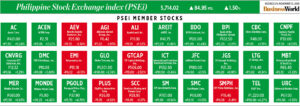PHILIPPINE MANUFACTURING activity in June expanded at its slowest pace in three months amid cooling demand, S&P Global said.
The S&P Global Philippines Manufacturing Purchasing Managers’ Index (PMI), which measures the country’s monthly factory performance, stood at 51.3 in June, slightly lower than the 51.9 reading in May.
June was the 10th consecutive month that PMI was above the 50 mark, which signals an improvement in operating conditions from the previous month. A reading below 50 indicates the opposite.
“While strong improvements in demand trends earlier in the second quarter allowed manufacturing firms to raise their production volumes at a solid and sustained rate in June, the recent cooling in demand conditions could mean weaker upticks in output as we move into the second half of the year,” S&P Global Market Intelligence economist Maryam Baluch said in a report.
The Philippines’ PMI reading was the third fastest among six Association of Southeast Asian Nations (ASEAN) member countries in June and lower than the ASEAN average of 51.7.
The Philippines was behind Vietnam (54.7) and Thailand (51.7), but ahead of Myanmar and Indonesia (50.7). Malaysia saw a slight contraction (49.9) in June.
The headline PMI measures manufacturing conditions through the weighted average of five indices — new orders (30%), output (25%), employment (20%), suppliers’ delivery times (15%) and stocks of purchases (10%).
S&P Global said Philippine manufacturers saw solid growth in production in June, the fastest in six months.
However, manufacturing firms saw “a notable cooldown” in growth in new orders. It noted the growth in foreign orders for Filipino-made goods weakened to a three-month low.
Cooling demand allowed manufacturers to address backlogs at the fastest pace in three months, S&P Global said.
It said manufacturing firms increased purchasing activity at the fastest pace since July 2023 in anticipation of rising production volume in the next few months.
“While growth in output fed through to higher purchasing activity, it failed to translate into job creation. The second consecutive month of job shedding reflected the lack of pressure on operating capacity within the sector, as backlogs were depleted sharply,” Ms. Baluch said.
S&P Global noted firms reduced workforce numbers in June due to rising spare capacity.
“June data also signaled a renewed rise in cost burdens, following a slight decrease in May. The rate of input price inflation was the strongest since February amid reports of raw material shortages, but nonetheless remained softer than the series average,” it said, noting this prompted firms to raise prices.
Rizal Commercial Banking Corp. Chief Economist Michael L. Ricafort said manufacturing’s continued expansion is “a bright spot for the economy, as partly reflected by the pickup in both exports and imports in recent months, especially electronics.”
“Lower Fed and local interest rates would help reduce borrowing costs and help spur greater demand for loans by some manufacturers,” Mr. Ricafort said.
Terry L. Ridon, a public investment analyst and convenor of think tank InfraWatch PH, said the government should keep a close eye on factory activity if it posts a decline for the rest of the year.
“Government should look at whether the three-month low was due to elevated electricity prices in the past three months, or whether global firms are starting to look to other economies to deliver on various orders,” he said in a Viber message.
S&P Global said Philippine manufacturers maintained a positive outlook for production in the next 12 months, although weaker than May’s recent high.
“Future expectations also retreated, further alluding to softening sentiment in the outlook. However, inflationary pressures remained in check, despite a renewed rise in operating costs. Relatively soft and subdued upticks in costs and charges could help the sector generate demand in the coming months,” Ms. Baluch said. — Beatriz Marie D. Cruz






